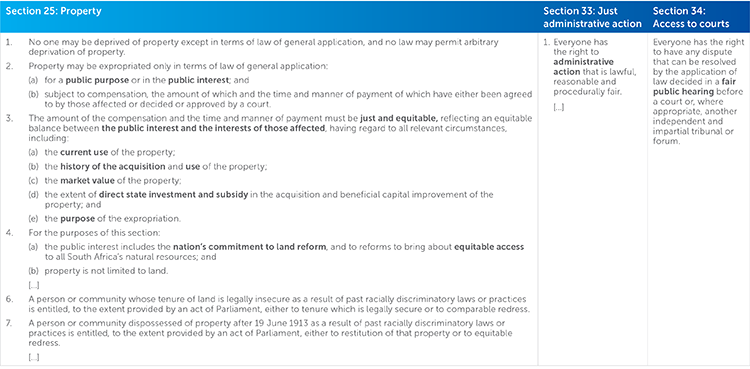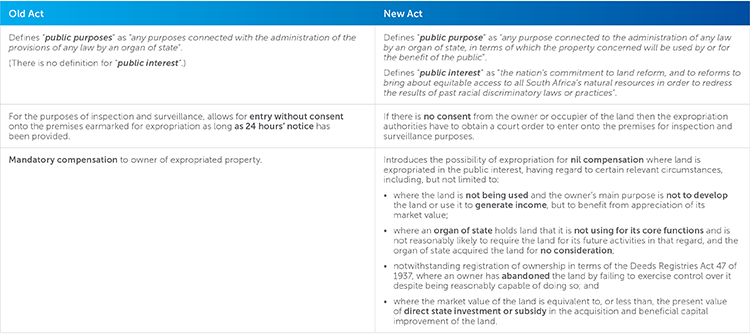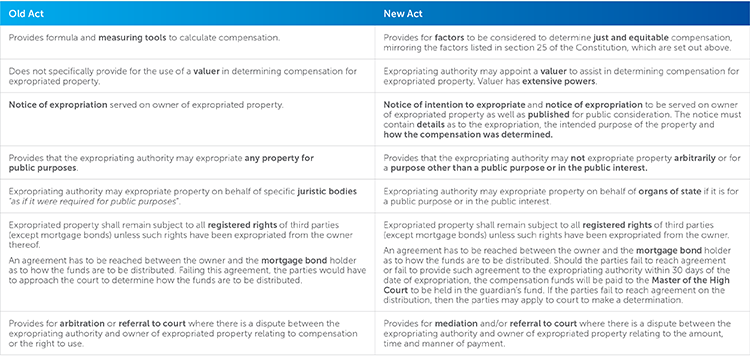Navigating change: The new Expropriation Act v the old Expropriation Act
At a glance
- The Expropriation Bill of 2020, as approved and signed-off by the President, was published on 24 January 2025.
- The purpose of the new act is to “provide for the expropriation of property for a public purpose or in the public interest”.
- The new act has introduced several changes to the law surrounding expropriation of land, the procedures which must be followed by expropriating authorities, and the recourse available to the owners of expropriated land. This article outlines some of these key changes.
As is highlighted in its preamble, the purpose of the New Act is to “provide for the expropriation of property for a public purpose or in the public interest”. It should be emphasised that “property” refers to both movable and immovable property. Our focus in this article is, however, on comparing certain changes in relation to immovable property. A notable addition to the purpose of the New Act is to “identify certain instances where the provision of nil compensation may be just and equitable for expropriation in the public interest”. This contrasts with the Old Act, which simply states that its purpose is to provide for “the expropriation of land and other property for public and certain other purposes”.
When considering the New Act, it is apparent that it adopts the language of the Constitution of the Republic of South Africa, 1996 (Constitution) throughout its provisions. The preamble further refers to sections 25, 33 and 34 of the Constitution, which provide as follows:

While there were discussions at a parliamentary level to amend the Constitution to specifically provide for expropriation without compensation, the relevant amendment bill did not proceed. However, Burton Meyer of CDH is of the view that such an amendment was not necessary in any event. Read more here.
The legislature seems to agree with this position given the additional purpose of the New Act highlighted above.
The New Act has introduced several changes to the law surrounding expropriation of land, the procedures which must be followed by expropriating authorities, and the recourse available to the owners of expropriated land. We highlight a few key differences between the Old Act and the New Act:


This is but the tip of the iceberg, beneath which there are more complex issues to unpack and understand.
To find out more, tune in to our webinar on Thursday, 13 February 2025 at 09h00 (CAT) Register here.
The information and material published on this website is provided for general purposes only and does not constitute legal advice. We make every effort to ensure that the content is updated regularly and to offer the most current and accurate information. Please consult one of our lawyers on any specific legal problem or matter. We accept no responsibility for any loss or damage, whether direct or consequential, which may arise from reliance on the information contained in these pages. Please refer to our full terms and conditions. Copyright © 2025 Cliffe Dekker Hofmeyr. All rights reserved. For permission to reproduce an article or publication, please contact us cliffedekkerhofmeyr@cdhlegal.com.
Subscribe
We support our clients’ strategic and operational needs by offering innovative, integrated and high quality thought leadership. To stay up to date on the latest legal developments that may potentially impact your business, subscribe to our alerts, seminar and webinar invitations.
Subscribe




